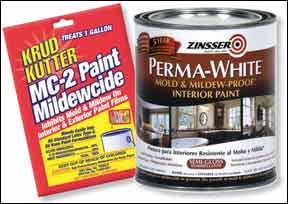I was wondering whether you might have any comments on using bottom paint on the boats interior to help fight mold and mildew. Many bottom paints are ineffective out of the water, but I was wondering whether some of the new eco-friendly paints might prove to be a new weapon in the fight to work less and play more.
Barry Simmons
Lighthouse Point, Fla.
We talked with a few major marine antifouling manufacturers, and they agreed that applying bottom paint to a cabin interior is not a recommended practice. Bottom paints are not formulated for interior use or to prevent mildew. Most come with labels warning against application in small spaces. Even the VOC-free, biocide-free, water-based eco-friendly paints have some risk when used in small confines. Aesthetics is another reason to leave bottom paint for the exterior: Antifouling paints lack gloss and would be a bear to keep clean; they absorb stains and odors more readily.

Photos courtesy of manufacturers and by Ralph Naranjo.
There are a number of better options for fighting mildew onboard-and they have fewer health risks and are less expensive than bottom paint.
Every anti-mildew strategy should start with keeping the boat dry and well-ventilated. Good air circulation and moisture control go a long way toward preventing mildew. To maximize ventilation, look into adding dorade boxes (PS, May 1997), solar hatch vents (PS, May 1, 1993), or 12-volt fans (PS, April 2008).
We recommend Marincos Nicro Day and Night solar-powered vents. During the day, a solar panel charges a small Nicad battery that powers the fan at night, giving you continuous circulation. The top cabin fans in our last test included the Hella Turbo (www.hella.com), Caframo Kona (www.caframo.com), Caframo Sirocco, Hotwire Port Fan (www.svhotwire.com), and the Fan-tastic Vent Endless Breeze (www.fantasticvent.com). Also check out the new Caframo Taku, reviewed in this issue.
For moisture control, consider using absorbent desiccan’ts (PS, November 2012) or a dehumidifier. Which chemical drying agent is best for you will depend on your boat and the planned application. We recommend the calcium-chloride Damp Rid (www.damprid.com) for closed-up boats, and Nordic Powers Nordic Dry (www.nordicdry.com) or Pindell Engineerings H2Out silica-gel SD309 (www.h2out.com) for spaces like large lockers. On problem boats in cooler climates, we also recommend fogging the boat interior with Concrobium prior to winter storage.
If youre planning to re-paint your cabin anyway, Practical Sailor Technical Editor Ralph Naranjo (a former boatyard manager) recommended using a latex house paint thats formulated to keep mildew at bay to paint lockers and other hidden interior hull surfaces. PS Editor Darrell Nicholson had good luck using Rustoleums Zinsser Perma-White ($10/quart) to protect the cabin of his wooden ketch. Rustoleum (www.rustoleum.com) claims the mold- and mildew-proof paint is moisture resistant and blisterproof. The company guarantees the water-based, self-priming paint will be mildew proof for five years. You can find it at Lowes, Amazon.com, and Sears.
There are also mildewcide paint additives that can be mixed with latex or oil-based paints and applied to a cabin interior. Rustoleum makes one called Add-2 Prevent Mildew Mildewcide, and Krud Kutter (www.krudkutter.com) markets a liquid, mildew-fighting additive called Supreme Chemical MC-2 Di-All; both are available online.
To protect your onboard gear-like life jackets, foul-weather gear, and cushions-you can use a spray-on preventative like those we tested in the June 2010 issue: Concrobium, Mold Off, and 3M Mildew Block. All did well in testing, but Concrobium was the leader of the pack. Its a safe, economical spray protectant.


































